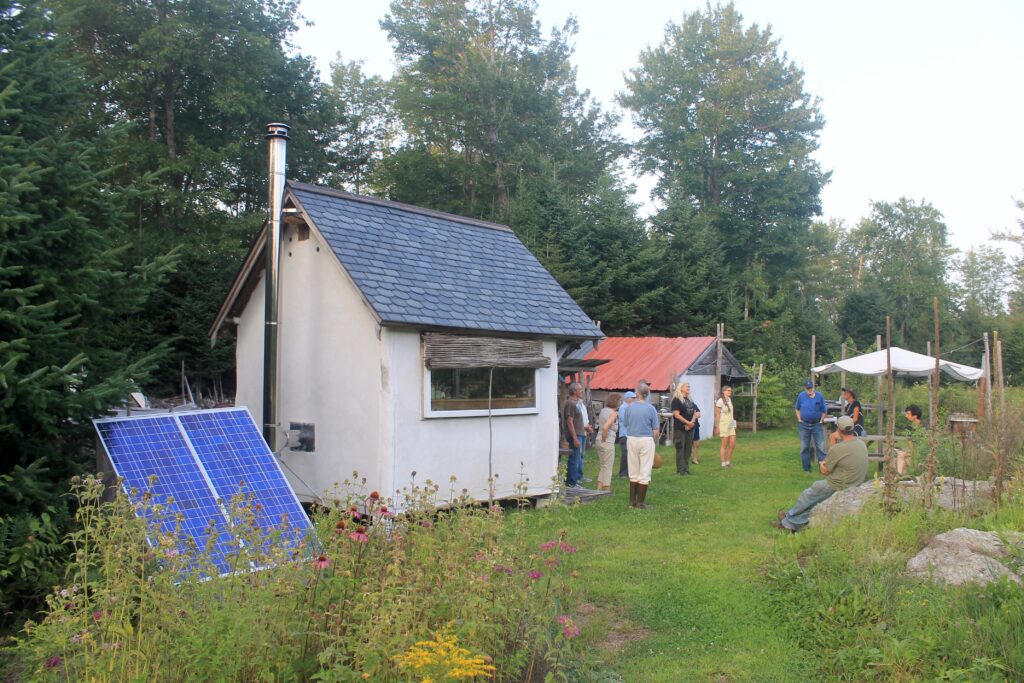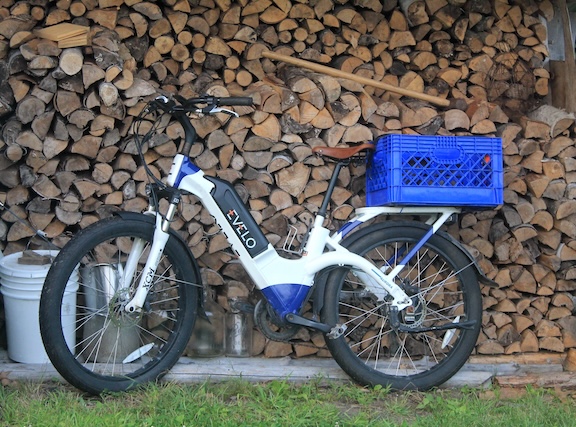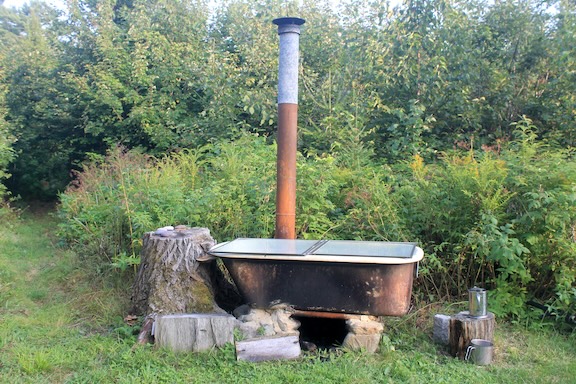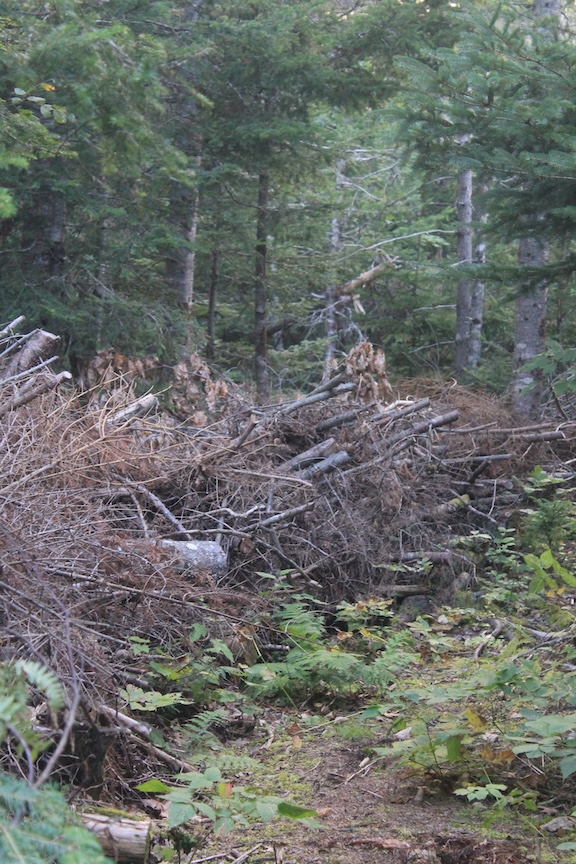By Holli Cederholm
On a given day, Alice Slater wakes, kicks up the fire in the woodstove, sets a kettle to boil, and makes tea. She might play an instrument, sing a new song, or send an email about an upcoming contradance she helps organize. Then, she heads outside to get moving: chopping firewood, cutting back trails, or hauling water. After a couple hours, she’s off to socialize. “That’s the best bit in life: just hanging out with friends,” she said.
Life wasn’t always this way. After 10 years in the workforce, Slater decided she didn’t want to spend all her time tethered to earning income. At 25 she gave away her online business — designing, manufacturing, and selling buttons, or “badges” as they call them in her native England, adorned with slogans, peace signs, and smiley faces — and moved out of her mother’s house. She went traveling, eventually finding her way to coastal Maine, where land, she said, was relatively affordable. In 2014, she purchased 17 acres with her savings, accumulated from a decade of wage earning and living simply, and resigned to live consciously.
“I don’t really have many things I want or need,” said Slater. “The idea of being able to work just one day a week to afford that lifestyle frees up a lot of time so I can spend it in the community, whether that’s putting on events, or spending quality time with friends, volunteering, doing things that interest me more than working 9-5.” She added, “All that good stuff doesn’t really cost money.”

Alice Slater giving a Gather & Grow tour of her homestead, including the house she built using natural materials, in Surry, Maine, in the summer of 2024. Photos by Holli Cederholm
I visited Slater’s land, which is tucked back in the woods from a quiet road in Surry, on an August afternoon in 2024. In a navy and white sundress, creased ball cap, and bare feet, Slater, 38, gave a tour to a small group interested in seeing how she lives more with less. Months later, I scheduled a phone call to further understand her focus on time, rather than money, as currency. It was a sunny day in early February with banner skies — a bluebird day in the language of skiers, who were likely flocking to slopes around the state to enjoy the 4 inches of fresh powder that fell the day before — and Slater asked to delay our call by 15 minutes. She needed to warm her hands, she texted, having just ridden her e-bike 3 miles from the nearby community center where she volunteers year-round.

Proximity to community was a non-negotiable that Slater kept in mind when scouting land for her future homestead: She wanted to be within 5 miles of a major town so that she could live car-free (having never owned a car in England). She ended up just 3 miles outside of Ellsworth by both road and water — she can drop a canoe into the Union River and paddle 55 minutes to town, provided the tide is right. In the winter, Slater dresses up “nice and warm” and outfits her bike with studded tires; this way, she’s able to ride “pretty comfortably” as long as it’s above 0 degrees Fahrenheit. This includes biking 12 miles each way to work, one day a week, at the local food co-op. She would have to work more to be able keep up with a vehicle: fuel, insurance, maintenance, and license renewals all add up. Being without a car allows her a lot of financial freedom — as do her other lifestyle choices.
In 2016, Slater and her then husband began living in Surry, staying in a tent while they enlarged a partial clearing at the end of a pine- and spruce-lined path for their house site. Today, this courtyard in the woods is a hub of domestic activity fueled largely by the sun and the resources the land provides: a tiny off-grid house sits near a stocked woodshed and tidy stacks of curing logs, an open shed for tool storage, a firepit, and a picnic table to dine al fresco.
Inside Slater’s home, you won’t find many standard appliances — aside from a blender and a slow cooker, which her 220-watt solar array, hooked up to a bank of golf-cart batteries, can power only on the sunniest of days. The panels regularly provide enough juice to charge her e-bike, laptop, phone, and an overhead light. (Still, Slater keeps candles on hand just in case.) She doesn’t have a TV, or a den to watch it in, an oven, a dishwasher, or even a refrigerator. While she has a washing machine, it’s not the automatic kind most of us take for granted: the agitator, like many of the tools in Slater’s life, requires human power.
Slater said, people “spend a lot of money on a home and don’t get to enjoy it” because they’re working to pay for it. While cycling around Morocco, Europe, Mexico, and elsewhere in her 20s, Slater glimpsed alternatives and was determined to take a different approach. Her 10-foot-by-10-foot house cost around $3,000.
The size of 100 square feet was chosen to keep property taxes low. Other building decisions were guided by a desire to leave less of a trace: the whole building could burn down or eventually rot away without doing harm to the landscape. “There’s no plastic in the house. That was part of my design criteria as well,” said Slater. As was using local materials whenever possible. “Construction waste is a huge contributor to the waste stream,” she added.
They harvested smaller trees from their land for a timber frame. Slater said these “round poles” are more difficult to work with than the square ones iconic to timber framing, but they are also easier to come by. They were “younger, inferior trees that you normally wouldn’t pick for building,” said Slater, but, she added, it was worth the effort. The frame was set upon a foundation of rubble and granite stones.
For the walls, they again opted for materials that could be sourced from close to home: wood chips and clay. Their heavy forest soils turn fine-grained and impermeable at 6 inches below ground level, and the two collected the earth to make a slurry, thinning it to a milk shake consistency in an outdoor bathtub. Slater stood in the tub, pressing water into the slippery clay with her bare toes on a summer day. Next, they added woodchips, sourced from their neighbor, and allowed the mixture to sit overnight and “get a bit tacky.” They used wooden forms, built out of boards, between the round poles to shape the mixture into four exterior walls, packing it in by hand, but not too hard — the air and woodchips act as insulation, while the clay provides thermal mass. Once the walls were set, they removed the forms and applied rendered clay to the interior and lime plaster to the exterior. For the latter, they whipped masonry plaster and water into a cream cheese consistency using a battery-powered drill with a paint-mixer attachment. Not having an immediate source of horse hair — a traditional plaster additive that helps bind the material and reduce cracking when it dries — they again turned to the land. Cattails were plentiful along the stream that cuts through the back of their parcel, and they pulled the fluffy seeds from mature heads as a substitute. Natural building can be somewhat forgiving, said Slater. “I kind of feel the same way in cooking. I can take any recipe and literally change every single ingredient and be pretty happy with how it comes out.”
The roof came from further afield. They loaded their car (which Slater’s ex-husband kept) with reclaimed slate from an old building and drove it north from Massachusetts. As slate is a natural material and doesn’t require any chemical treatments, the roof also plays a role in water catchment. The one-room building doesn’t have any plumbing, and Slater has various systems in place for gathering water. She lines up buckets under the roof’s drip line, collecting water for cooking and drinking, and also hauls water from a shallow well on the property, carrying it with a yoke and two buckets the six-minute round-trip back to her house. “Because I carry it by hand, I really don’t waste water,” said Slater. Five gallons every other day is enough for cooking, drinking, and dishwashing. To be more adaptable in times of drought, she plans to set up a gutter system to divert rain water to a 300-gallon stainless steel milk tank.

A parabolic solar cooker reflects sunlight, replacing the need for fuel for cooking.
Without indoor plumbing, Slater doesn’t have to worry about the pipes freezing in the winter. Though the dwelling — her “cozy little cave,” as she calls it — is quite easy to heat. In fact, she went the first three winters with wool blankets tacked over the entrance in lieu of a door, despite not having finished insulating the cabin’s roof.
The space is essentially half kitchen and half bedroom, with a cast-iron woodstove at its center. A small storage loft is accessible via a bookshelf as a make-do staircase. “All I do in the house is sleep and eat,” said Slater.
She cooks on the woodstove, which has a 12-inch fire box, in the winter months, lifting its circular cast-iron burners to set a pot or pan directly on the flames within. The rest of the year cooking is done outside. Before their divorce, the couple did a lot of campfire cooking in the summer months, but Slater has since found more efficient ways to cook for one. She purchased a parabolic solar cooker secondhand on eBay for around $70. A large silver disk shaped like a satellite reflects sunlight onto a central stand, where Slater can place a stir-fry or a pot of soup or a hot water bath for canning or anything else she wants to heat. “I couldn’t believe how well it works,” said Slater. It almost works too well — Slater has to be careful to face the cooker away from the sun or place a sheet over it when not in use, to prevent a fire. “It’s very cool low-tech stuff,” said Slater, who noted that it makes living off-grid in the summer so much easier. “Free heat from the sun is pretty awesome.”
Slater has also rigged up a free source of cooling. For perishable food storage, she sunk a galvanized wash tub a foot deep in the ground, in a shady spot behind her house. She places food — produce, a jar of home-made pesto, a container of leftovers — on bricks in the basin, covering the tub with a wooden board and a sheet of metal. It is not weather-proof, and Slater said that pooling rainwater has an evaporative effect in the warm months. Generally, the air inside is about 10 degrees cooler than the temperature outside.
While this method isn’t a direct replacement for refrigeration, Slater said it keeps milk fresh for a few days — and she isn’t in the habit of stockpiling food. Rather, she procures it as she needs it. Slater no longer gardens, as she doesn’t like it enough to do it, and relies instead on local growers. Food is easy to access and relatively affordable, she said. It helps that she gets plenty of food not suitable for sale through her employment at the co-op — it is therefore “rescued from the waste stream.” In the winter, Slater uses a cool spot in the house for perishables.

Slater’s “bathroom” also makes use of natural systems. In the summer, she fills a cast-iron tub (the same one she mixed her house walls in) with rain or stream water and places an old glass storm window over it to harness the sun’s warmth. In the winter, she continues to bath outside as long as the temperature is in the upper 20s or above. Slater lights a fire under the tub, which is up on blocks, and melts snow to the desired fill. After the 30 to 60 minutes it takes for the water to heat, she climbs into the tub and sits on a board to avoid getting scalded. Reflecting on seeing a shooting star while bathing, Slater said, “Oh yeah, this was totally worth all the work.”

Slater also eliminates waste outdoors. Her toilet is a trench in the orchard, which she prefers to both an indoor compost toilet and an outhouse. She doesn’t have to haul buckets of humanure to where she wants the fertilizer to go, and there’s no cold toilet seat or spiders in a corner. When there’s weather, she brings an umbrella. Even in a snowstorm, it’s often the best part of her day, she said.
She keeps a map of the trenches, which are about the width of a shovel and as deep as she “could be bothered to dig.” When one reaches capacity, Slater backfills the squat toilet with soil from the original hole and digs another near one of her dozen or so fruit trees.
The dwarf trees have begun bearing fruit, supplying Slater with ample harvests. She credits her “dead hedge” for deer protection. Around the house and orchard, Slater is working on cutting smaller trees, in 5-foot-deep swaths, to around human height. The result is as its name implies: a hedge of trees that dies back. It creates a fencing system — for free. In addition to dissuading deer, the hedge, which looks like a massive brush pile, can be used to support grape or hardy kiwi vines. While Slater doesn’t care much for gardening, she does enjoy managing the land. Her projects these days center around “keeping the forest at bay.” She said, “I feel like I’m more camping than homesteading now.”
And she’s more than ok with that. “My goal is to be happy with everything as it is,” said Slater. “I have food, I have water, I have shelter. Everything else is just beauty.”
This article was originally published in the summer 2025 issue of The Maine Organic Farmer & Gardener.
Please note: Readers are encouraged to check with their town office regarding local building code.